Review of Recent Metamaterial Microfluidic Sensors
Abstract
:1. Introduction
Qualification Parameters of Microfluidic Sensors
2. Metamaterial Based Microfluidic Sensors
2.1. Metamaterial Inspired Microfluidic Chemical Sensors Using Rigid Substrates
2.2. Metamaterial Inspired Microfluidic Chemical Sensors Using Flexible Substrates
2.3. Metamaterial Inspired Microfluidic Biosensors
3. Challenges and Strategies
4. Conclusions
Acknowledgments
Author Contributions
Conflicts of Interest
References
- Smith, D.R.; Smith, D.R.; Pendry, J.B.; Wiltshire, M.C.K. Metamaterials and negative refractive index. Science 2004, 305, 788–792. [Google Scholar] [CrossRef] [PubMed]
- Shelby, R.A.; Smith, D.R.; Schultz, S. Experimental verification of a negative index of refraction. Science 2001, 292, 77–79. [Google Scholar] [CrossRef] [PubMed]
- Sadeqi, A.; Sonkusale, S. Low-cost metamaterial-on-paper chemical sensor. Transducers Int. Conf. Solid-State Sens. Actuators Microsyst. 2017, 25, 1437–1440. [Google Scholar] [CrossRef]
- Salim, A.; Lim, S. Complementary split-ring resonator-loaded microfluidic ethanol chemical sensor. Sensors 2016, 16, 1802. [Google Scholar] [CrossRef] [PubMed]
- Selga, J.; Siso, G. Recent advances in metamaterial transmission lines based on split rings. Proc. IEEE 2011, 99, 1701–1710. [Google Scholar]
- Lim, S.; Caloz, C.; Itoh, T. Metamaterial-based electronically controlled transmission-line structure as a novel leaky-wave antenna with tunable. IEEE Trans. Microw. Theory Tech. 2004, 52, 2678–2690. [Google Scholar] [CrossRef]
- Lee, H. Effect of loading split-ring resonators in a microstrip antenna ground plane. J. Electromagn. Eng. Sci. 2015, 15, 120–122. [Google Scholar] [CrossRef]
- Martin, F.; Falcone, F.; Bonache, J.; Marques, R.; Sorolla, M. Miniaturized coplanar waveguide stop band filters based on multiple tuned split ring resonators. IEEE Microw. Wirel. Compon. Lett. 2003, 13, 511–513. [Google Scholar] [CrossRef]
- Ling, K.; Yoo, M.; Su, W.; Kim, K.; Cook, B.; Tentzeris, M.M.; Lim, S. Microfluidic tunable inkjet-printed metamaterial absorber on paper. Opt. Express 2015, 23, 110–120. [Google Scholar] [CrossRef] [PubMed]
- Bage, A.; Das, S. Studies of some non conventional split ring and complementary split ring resonators for waveguide band stop & band pass filter application. In Proceedings of the 2013 International Conference on Microwave and Photonics ICMAP, Dhanbad, India, 13–15 December 2013; pp. 1–5. [Google Scholar] [CrossRef]
- Rawat, V.; Dhobale, S.; Kale, S.N. Ultra-fast selective sensing of ethanol and petrol using microwave-range metamaterial complementary split-ring resonators. J. Appl. Phys. 2014, 116, 1–6. [Google Scholar] [CrossRef]
- Lee, H.J.; Lee, H.S.; Yoo, K.H.; Yook, J.G. DNA sensing using split-ring resonator alone at microwave regime. J. Appl. Phys. 2010, 108. [Google Scholar] [CrossRef]
- Whitesides, G.M. The origins and the future of microfluidics. Nature 2006, 442, 368–373. [Google Scholar] [CrossRef] [PubMed]
- Kobel, S.; Lutolf, M.P. Biomaterials meet microfluidics: Building the next generation of artificial niches. Curr. Opin. Biotechnol. 2011, 22, 690–697. [Google Scholar] [CrossRef] [PubMed]
- Borse, M.; Bhushan, S.; Walters, D.K.; Burgreen, G.W. Numerical simulations of flow pattern and particle trajectories in feline aorta for hypertrophic cardiomyopathy heart conditions. Eng. Appl. Comput. Fluid Mech. 2018, 12, 57–73. [Google Scholar] [CrossRef]
- Jiang, J.; Cai, H.; Ma, C.; Qian, Z.; Chen, K.; Wu, P. A ship propeller design methodology of multi-objective optimization considering fluid–structure interaction. Eng. Appl. Comput. Fluid Mech. 2018, 12, 28–40. [Google Scholar] [CrossRef]
- Zhang, S.; Zhang, B.; Tezdogan, T.; Xu, L.; Lai, Y. Computational fluid dynamics-based hull form optimization using approximation method. Eng. Appl. Comput. Fluid Mech. 2018, 12, 74–88. [Google Scholar] [CrossRef]
- Jeong, H.-S.; Kim, K.-Y. Shape optimization of a feedback-channel fluidic oscillator. Eng. Appl. Comput. Fluid Mech. 2018, 12, 169–181. [Google Scholar] [CrossRef]
- Han, Y.; Ding, G.; He, Y.; Wu, J.; Le, J. Assessment of the IDDES method acting as wall-modeled LES in the simulation of spatially developing supersonic flat plate boundary layers. Eng. Appl. Comput. Fluid Mech. 2018, 12, 89–103. [Google Scholar] [CrossRef]
- Wang, W.; Yuan, B.; Su, Y.; Sheng, G.; Yao, W.; Gao, H.; Wang, K. A composite dual-porosity fractal model for channel-fractured horizontal wells. Eng. Appl. Comput. Fluid Mech. 2018, 12, 104–116. [Google Scholar] [CrossRef]
- Artis, F.; Chen, T.; Chretiennot, T.; Fournie, J.-J.; Poupot, M.; Dubuc, D.; Grenier, K. Microwaving biological cells: Intracellular analysis with microwave dielectric spectroscopy. IEEE Microw. Mag. 2015, 16, 87–96. [Google Scholar] [CrossRef]
- Chen, Y.; Wu, H.; Hong, Y.; Lee, H. New RF biosensor based on planar LC resonant circuit for human cancer cells characterization. Int. J. Sci. Eng. 2014, 4, 335–338. [Google Scholar] [CrossRef]
- Chen, T.; Artis, F.; Dubuc, D.; Fournie, J.J.; Poupot, M.; Grenier, K. Microwave biosensor dedicated to the dielectric spectroscopy of a single alive biological cell in its culture medium. In Proceedings of the IEEE MTT-S International Microwave Symposium Digest, Seattle, WA, USA, 2–7 June 2013; pp. 7–10. [Google Scholar] [CrossRef]
- Artis, F.; Dubuc, D.; Fournie, J.-J.; Poupot, M.; Grenier, K. Microwave dielectric bio-sensing for precise and repetitive living cells suspension analysis. Eur. Microw. Conf. 2013, 468–470. [Google Scholar] [CrossRef]
- Bǎnicǎ, F.G. Chemical Sensors and Biosensors: Fundamentals and Applications; John Wiley & Sons: Hoboken, NJ, USA, 2012; ISBN 9780470710661. [Google Scholar]
- Jacob, F. Handbook of Modern Sensors: Physics, Designs, and Applications, 3rd ed.; AIP Press, Springer Inc.: New York, NY, USA, 2004; ISBN 0-387-00750-4. [Google Scholar]
- Shrivastava, A.; Gupta, V. Methods for the determination of limit of detection and limit of quantitation of the analytical methods. Chronicles Young Sci. 2011, 2, 21. [Google Scholar] [CrossRef]
- Salim, A.; Kim, S.; Park, J.Y.; Lim, S. Microfluidic biosensor based on microwave substrate integrated waveguide cavity resonator. J. Sens. 2017. accepted. [Google Scholar]
- Azar, M.T. Microactuators Electrical, Magnetic, Thermal, Optical, Mechanical, Chemical & Smart Structures, 1st ed.; Springer Science + Business Media: New York, NY, USA, 1998. [Google Scholar]
- Abduljabar, A.A.; Rowe, D.J.; Porch, A.; Barrow, D.A. Novel microwave microfluidic sensor using a microstrip split-ring resonator. IEEE Trans. Microw. Theory Tech. 2014, 62, 679–688. [Google Scholar] [CrossRef]
- De la Hoz, A.; Loupy, A. Microwaves in Organic Synthesis, 3rd ed.; WILEY-VCH Verlag GmbH & Co.: Weinheim, Germany, 2013; Volume 1, ISBN 3527314520. [Google Scholar]
- Guarin, G.; Hofmann, M.; Nehring, J.; Weigel, R.; Fischer, G. Miniature microwave biosensors. IEEE Microw. Mag. 2015, 16, 71–86. [Google Scholar] [CrossRef]
- Withayachumnankul, W.; Jaruwongrungsee, K.; Tuantranont, A.; Fumeaux, C.; Abbott, D. Metamaterial-based microfluidic sensor for dielectric characterization. Sens. Actuators A Phys. 2013, 189, 233–237. [Google Scholar] [CrossRef]
- Ebrahimi, A.; Withayachumnankul, W.; Al-Sarawi, S.; Abbott, D. High-Sensitivity Metamaterial-Inspired Sensor for Microfluidic Dielectric Characterization. IEEE Sens. J. 2014, 14, 1345–1351. [Google Scholar] [CrossRef]
- Kim, H.K.; Yoo, M.; Lim, S. Novel ethanol chemical sensor using microfluidic metamaterial. In Proceedings of the IEEE International Symposium on Antennas and Propagation & USN National Radio Science Meeting, Vancouver, BC, Canada, 19–24 July 2015; pp. 1358–1359. [Google Scholar] [CrossRef]
- Seo, Y.; Memon, M.U.; Lim, S. Microfluidic eighth-mode substrate-integrated- waveguide Antenna for Compact ethanol chemical sensor application. IEEE Trans. Antennas Propag. 2016, 64, 3218–3222. [Google Scholar] [CrossRef]
- Byford, J.A.; Park, K.Y.; Chahal, P. Metamaterial inspired periodic structure used for microfluidic sensing. In Proceedings of the Electronic Components Technology Conference, San Diego, CA, USA, 26–29 May 2015; pp. 1997–2002. [Google Scholar] [CrossRef]
- Bakir, M. Electromagnetic-based microfluidic sensor applications. J. Electrochem. Soc. 2017, 164, B488–B494. [Google Scholar] [CrossRef]
- Velez, P.; Su, L.; Grenier, K.; Mata-Contreras, J.; Dubuc, D.; Martin, F. Microwave microfluidic sensor based on a microstrip splitter/combiner configuration and split ring Resonators (SRRs) for dielectric characterization of liquids. IEEE Sens. J. 2017, 17, 6589–6598. [Google Scholar] [CrossRef]
- Awang, R.A.; Tovar-Lopez, F.J.; Baum, T.; Sriram, S.; Rowe, W.S.T. Meta-atom microfluidic sensor for measurement of dielectric properties of liquids. J. Appl. Phys. 2017, 121. [Google Scholar] [CrossRef]
- Withayachumnankul, W.; Jaruwongrungsee, K.; Fumeaux, C.; Abbott, D. Metamaterial-Inspired Multichannel Thin-Film Sensor. IEEE Sens. J. 2012, 12, 1455–1458. [Google Scholar] [CrossRef]
- Shih, K.; Pitchappa, P.; Manjappa, M.; Ho, C.P.; Singh, R.; Lee, C. Microfluidic metamaterial sensor: Selective trapping and remote sensing of microparticles. J. Appl. Phys. 2017, 121. [Google Scholar] [CrossRef]
- Nguyen, T.T.; Lim, S. Wide incidence angle-insensitive metamaterial absorber for both TE and TM polarization using eight-circular-sector. Sci. Rep. 2017, 7, 1–11. [Google Scholar] [CrossRef] [PubMed]
- Lim, D.; Lee, D.; Lim, S. Angle- and polarization-insensitive metamaterial absorber using via array. Sci. Rep. 2016, 6, 1–9. [Google Scholar] [CrossRef] [PubMed]
- Lee, D.; Jeong, H.; Lim, S. Electronically switchable broadband metamaterial absorber. Sci. Rep. 2017, 7, 1–10. [Google Scholar] [CrossRef] [PubMed]
- Trungo, N.T.; Lim, S. Metamaterial absorber using complementary circular sector resonator. In Proceedings of the 2016 International Symposium on Antennas and Propagation (ISAP), Okinawa, Japan, 24–28 October 2016; pp. 176–177. [Google Scholar]
- Yoo, M.; Lim, S. Polarization-independent and ultrawideband metamaterial absorber using a hexagonal artificial impedance surface and a resistor-capacitor layer. IEEE Trans. Antennas Propag. 2014, 62, 2652–2658. [Google Scholar] [CrossRef]
- Kim, H.K.; Lee, D.; Lim, S. A fluidically tunable metasurface absorber for flexible large-scale wireless ethanol sensor applications. Sensors 2016, 16, 1246. [Google Scholar] [CrossRef] [PubMed]
- Salim, A.; Lim, S. Review of recent inkjet-printed capacitive tactile sensors. Sensors 2017, 17, 2593. [Google Scholar] [CrossRef] [PubMed]
- Choi, S.; Eom, S.; Tentzeris, M.M.; Lim, S. Inkjet-printed electromagnet-based touchpad using spiral resonators. J. Microelectromech. Syst. 2016, 25, 947–953. [Google Scholar] [CrossRef]
- Memon, M.U.; Tentzeris, M.M.; Lim, S. Inkjet-printed 3D Hilbert-curve fractal antennas for VHF band. Microw. Opt. Technol. Lett. 2017, 59, 1698–1704. [Google Scholar] [CrossRef]
- Boybay, M.S. Behavior of metamaterial-based microwave components for sensing and heating of nanoliter-scale volumes. Turk. J. Electr. Eng. Comput. Sci. 2016, 24, 3503–3512. [Google Scholar] [CrossRef]
- Yurish, S.Y. Sensors and Biosensors, MEMS Technologies and Its Applications, Advances in Sensors: Reviews; International Frequency Sensor Association Publishing: Barcelona, Spain, 2013; Volume 2. [Google Scholar]
- Chen, Y.; Wu, H.; Hong, Y.; Lee, H. Biosensors and Bioelectronics 40 GHz RF biosensor based on microwave coplanar waveguide transmission line for cancer cells (HepG2) dielectric characterization. Biosens. Bioelectron. 2014, 61, 417–421. [Google Scholar] [CrossRef] [PubMed]
- Gregory, A.P.; Clarke, R.N. Tables of the Complex Permittivity of Dielectric Reference Liquids at Frequencies up to 5 GHz; NPL Report MAT 23; National Physical Laboratory: Teddington, UK, 2012. [Google Scholar]
- Meissner, T.; Wentz, F.J. The complex dielectric constant of pure and sea water from microwave satellite observations. IEEE Trans. Geosci. Remote Sens. 2004, 42, 1836–1849. [Google Scholar] [CrossRef]
- Murata, K.I.; Hanawa, A.; Nozaki, R. Broadband complex permittivity measurement techniques of materials with thin configuration at microwave frequencies. J. Appl. Phys. 2005, 98. [Google Scholar] [CrossRef]
- Ikyumbur, T.; Onimisi, M.; Abdu, S.; Hemba, E.; Kirji, Z. Optimization in the computation of dielectric constant of methanol using Debye relaxation method. Br. J. Appl. Sci. Technol. 2017, 19, 1–10. [Google Scholar] [CrossRef]
- Schwan, H.P.; Foster, K.R. RF-Field interactions with biological systems: Electrical properties and biophysical mechanisms. Proc. IEEE 1980, 68, 104–113. [Google Scholar] [CrossRef]
- Schwan, H.P. Electrical properties of tissues and cell suspensions: Mechanisms and models. In Proceedings of the 16th Annual International Conference of the IEEE Engineering in Medicine Biology Society, Baltimore, MD, USA, 3–6 November 1994; pp. 70–71. [Google Scholar] [CrossRef]
- Park, S.J.; Hong, J.T.; Choi, S.J.; Kim, H.S.; Park, W.K.; Han, S.T.; Park, J.Y.; Lee, S.; Kim, D.S.; Ahn, Y.H. Detection of microorganisms using terahertz metamaterials. Sci. Rep. 2014, 4, 1–7. [Google Scholar] [CrossRef] [PubMed]
- Yi, G.; Kim, W.K.H.; Pack, S.J.J. A prototype system for early-stage breast cancer detection. J. Electromagn. Eng. Sci. 2015, 15, 158–166. [Google Scholar] [CrossRef]
- Brenner, D.J.; Hall, E.J. Computed tomography—An increasing source of radiation exposure. N. Engl. J. Med. 2007, 357, 2277–2284. [Google Scholar] [CrossRef] [PubMed]
- Son, S.H.; Kim, H.J.; Lee, K.J.; Kim, J.Y.; Lee, J.M.; Jeon, S.I.; Choi, H.D. Experimental measurement system for 3–6 GHz microwave breast tomography. J. Electromagn. Eng. Sci. 2015, 15, 250–257. [Google Scholar] [CrossRef]
- Stuchly, S.S.; Bassey, C.E. Microwave coplanar sensors for dielectric measurements. Meas. Sci. Technol. 1998, 9, 1324–1329. [Google Scholar] [CrossRef]
- Facer, G.R.; Notterman, D.A.; Sohn, L.L. Dielectric spectroscopy for bioanalysis: From 40 Hz to 26.5 GHz in a microfabricated wave guide. Appl. Phys. Lett. 2001, 78, 996–998. [Google Scholar] [CrossRef]
- Seo, S.; Stintzing, T.; Block, I.; Pavlidis, D.; Rieke, M.; Layer, P.G. High frequency wideband permittivity measurements of biological substances using coplanar waveguides and application to cell suspensions. In Proceedings of the IEEE MTT-S International Microwave Symposium Digest, Atlanta, GA, USA, 15–20 June 2008; pp. 915–918. [Google Scholar] [CrossRef]
- PYREX 7740 Glass_Data Sheet. Available online: http://www.quartz.com/pxprop.pdf (accessed on 16 November 2017).
- Lee, H.J.; Lee, J.H.; Moon, H.S.; Jang, I.S.; Choi, J.S.; Yook, J.G.; Jung, H. Il A planar split-ring resonator-based microwave biosensor for label-free detection of biomolecules. Sens. Actuators B Chem. 2012, 169, 26–31. [Google Scholar] [CrossRef]
- Torun, H.; Cagri Top, F.; Dundar, G.; Yalcinkaya, A.D. An antenna-coupled split-ring resonator for biosensing. J. Appl. Phys. 2014, 116. [Google Scholar] [CrossRef]
- Lee, H.J.; Yook, J.G. Biosensing using split-ring resonators at microwave regime. Appl. Phys. Lett. 2008, 92, 10–13. [Google Scholar] [CrossRef]
- Chen, T.; Li, S.; Sun, H. Metamaterials application in sensing. Sensors 2012, 12, 2742–2765. [Google Scholar] [CrossRef] [PubMed]
- Hofmann, M.; Fersch, T.; Weigel, R.; Fischer, G.; Kissinger, D. A novel approach to non-invasive blood glucose measurement based on RF transmission. IEEE Int. Symp. Med. Meas. Appl. 2011, 39–42. [Google Scholar] [CrossRef]
- Yvanoff, M.; Venkataraman, J. A feasibility study of tissue characterization using LC sensors. IEEE Trans. Antennas Propag. 2009, 57, 885–893. [Google Scholar] [CrossRef]
- Leroy, J.; Hjeij, F.; Dalmay, C.; Melin, C.; Lalloue, F.; Battu, S.; Jauberteau, M.O.; Lautrette, C.; Bessaudou, A.; Blondy, P.; et al. High frequency microfluidic biosensors for intracellular dielectric spectroscopy. In Proceedings of the 2015 IEEE MTT-S International Microwave Symposium (IMS), Phoenix, AZ, USA, 17–22 May 2015; pp. 1–4. [Google Scholar] [CrossRef]
- Dalmay, C.; Pothier, A.; Blondy, P.; Cheray, M.; Lalloue, F.; Jauberteau, M.; Thomas, A.; Cedex, L. RF biosensor based on microwave filter for biological cell characterisation. In Proceedings of the 39th European Microwave Conference (RF), Rome, Italy, 29 September–1 October 2009; pp. 41–44. [Google Scholar]
- Jaruwongrungsee, K.; Waiwijit, U.; Withayachumnankul, W. Real-time and label-free biosensing with microfluidic-based split-ring-resonator sensor. In Proceedings of the 2015 IEEE 15th International Conference on Nanotechnology (IEEE-NANO), Rome, Italy, 27–30 July 2015; pp. 1091–1094. [Google Scholar]
- Zijlstra, P.; Paulo, P.M.R.; Orrit, M. Optical detection of single non-absorbing molecules using the surface Plasmon resonance of a gold nanorod. Nat. Nanotechnol. 2012, 7, 379–382. [Google Scholar] [CrossRef] [PubMed]
- Chen, M.; Fan, F.; Shen, S.; Wang, X.; Chang, S. Terahertz ultrathin film thickness sensor below λ/90 based on metamaterial. Appl. Opt. 2016, 55, 6471–6474. [Google Scholar] [CrossRef] [PubMed]
- Wu, P.C.; Sun, G.; Chen, W.T.; Yang, K.Y.; Huang, Y.W.; Chen, Y.H.; Huang, H.L.; Hsu, W.L.; Chiang, H.P.; Tsai, D.P. Vertical split-ring resonator based nanoplasmonic sensor. Appl. Phys. Lett. 2014, 105, 3898. [Google Scholar] [CrossRef]
- Aristov, A.I.; Manousidaki, M.; Danilov, A.; Terzaki, K.; Fotakis, C.; Farsari, M.; Kabashin, A.V. 3D plasmonic crystal metamaterials for ultra-sensitive biosensing. Sci. Rep. 2016, 6, 1–8. [Google Scholar] [CrossRef] [PubMed]
- Lee, D.-K.K.; Kang, J.-H.H.; Lee, J.-S.S.; Kim, H.-S.S.; Kim, C.; Hun Kim, J.; Lee, T.; Son, J.-H.H.; Park, Q.-H.H.; Seo, M. Highly sensitive and selective sugar detection by terahertz nano-antennas. Sci. Rep. 2015, 5, 1–7. [Google Scholar] [CrossRef] [PubMed]
- Afapour, Z.O.V.; Ajati, Y.A.H.; Ajati, M.O.H. Graphene-based mid-infrared biosensor. J. Opt. Soc. Am. B 2017, 34, 2586–2592. [Google Scholar] [CrossRef]
- Kabashin, A.V.; Evans, P.; Pastkovsky, S.; Hendren, W.; Wurtz, G.A.; Atkinson, R.; Pollard, R.; Podolskiy, V.A.; Zayats, A.V. Plasmonic nanorod metamaterials for biosensing. Nat. Mater. 2009, 8, 867–871. [Google Scholar] [CrossRef] [PubMed]
- Sreekanth, K.V.; Alapan, Y.; ElKabbash, M.; Ilker, E.; Hinczewski, M.; Gurkan, U.A.; De Luca, A.; Strangi, G. Extreme sensitivity biosensing platform based on hyperbolic metamaterials. Nat. Mater. 2016, 15, 621–627. [Google Scholar] [CrossRef] [PubMed]
- Geng, Z.; Zhang, X.; Fan, Z.; Lv, X.; Chen, H. A route to terahertz metamaterial biosensor integrated with microfluidics for liver cancer biomarker testing in early stage. Sci. Rep. 2017, 7, 1–11. [Google Scholar] [CrossRef] [PubMed]
- Council, N.R. Expanding the Vision of Sensor Materials; The National Academies Press: Washington, DC, USA, 1995. [Google Scholar]
- Mohammadi, A.; Ismail, A.; Adzir, M.; Syamsul, R.; Raja, A. Carbon-nanotube-based FR-4 Patch Antenna as a bio-material sensor. Procedia Eng. 2012, 41, 724–728. [Google Scholar] [CrossRef]
- Ali, M.A.; Cheng, M.M.C.; Chen, J.C.M.; Wu, C.T.M. Microwave gas sensor based on graphene-loaded substrate integrated waveguide cavity resonator. In Proceedings of the IEEE MTT-S International Microwave Symposium (IMS), San Francisco, CA, USA, 22–27 May 2016; pp. 4–7. [Google Scholar] [CrossRef]
- Lee, H.J.; Yook, J.G. Recent research trends of radio-frequency biosensors for biomolecular detection. Biosens. Bioelectron. 2014, 61, 448–459. [Google Scholar] [CrossRef] [PubMed]
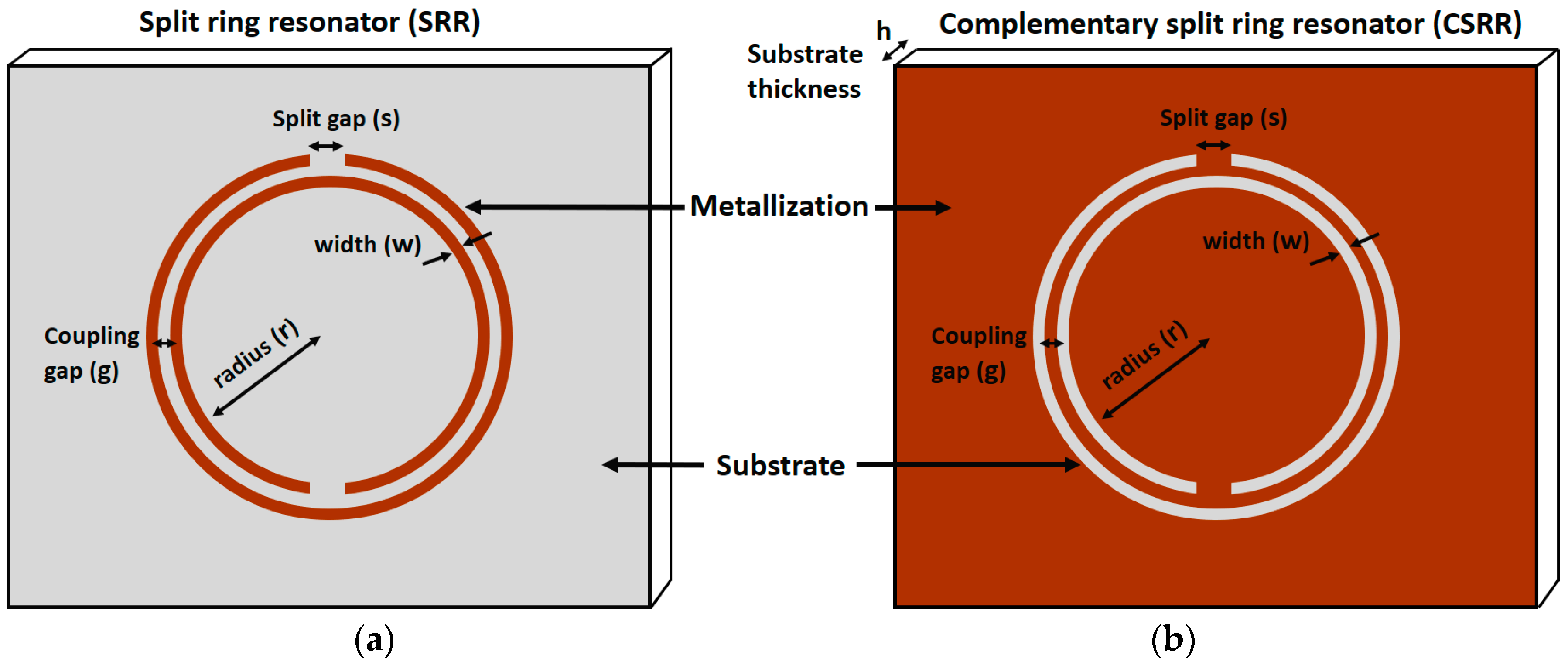
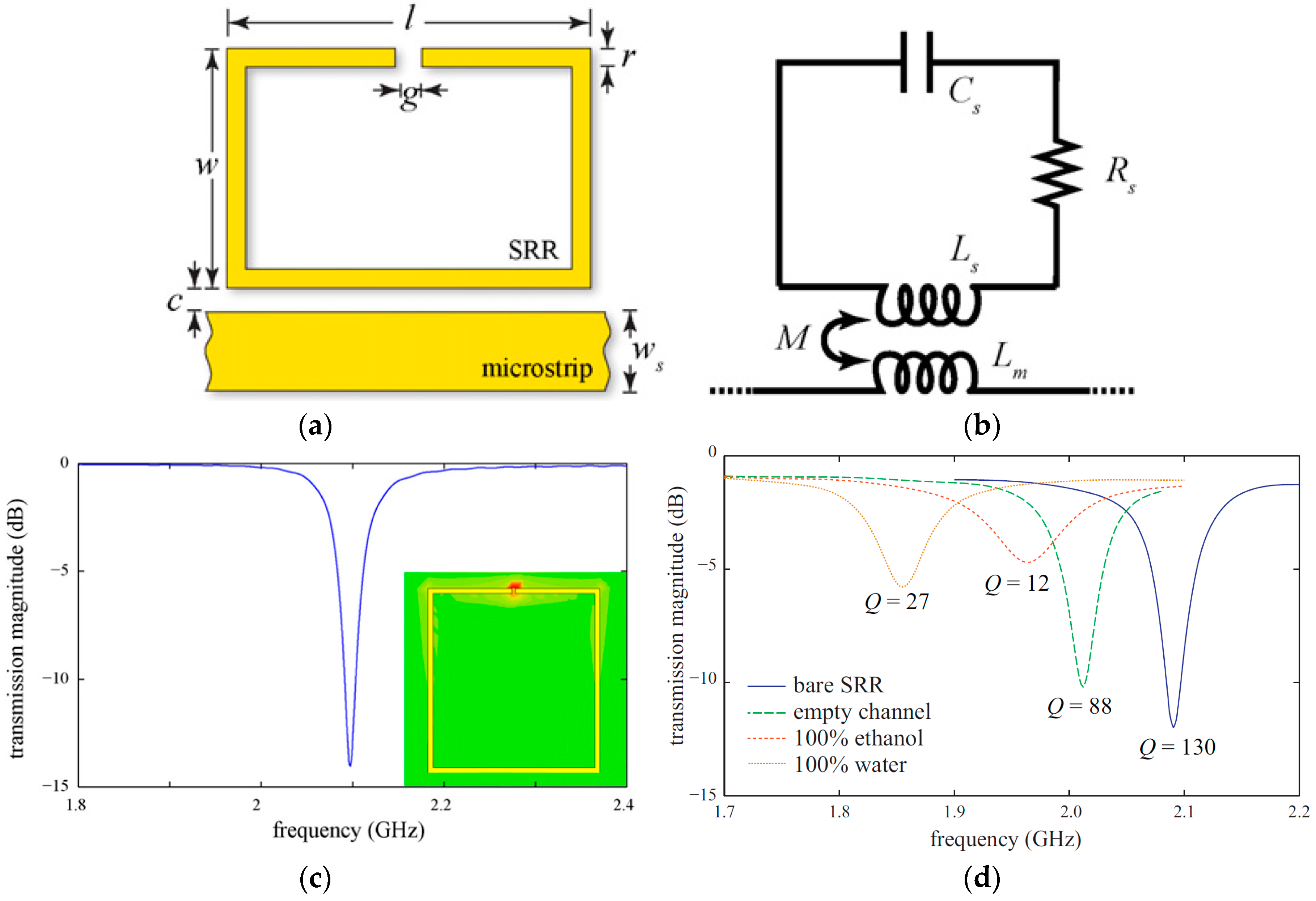
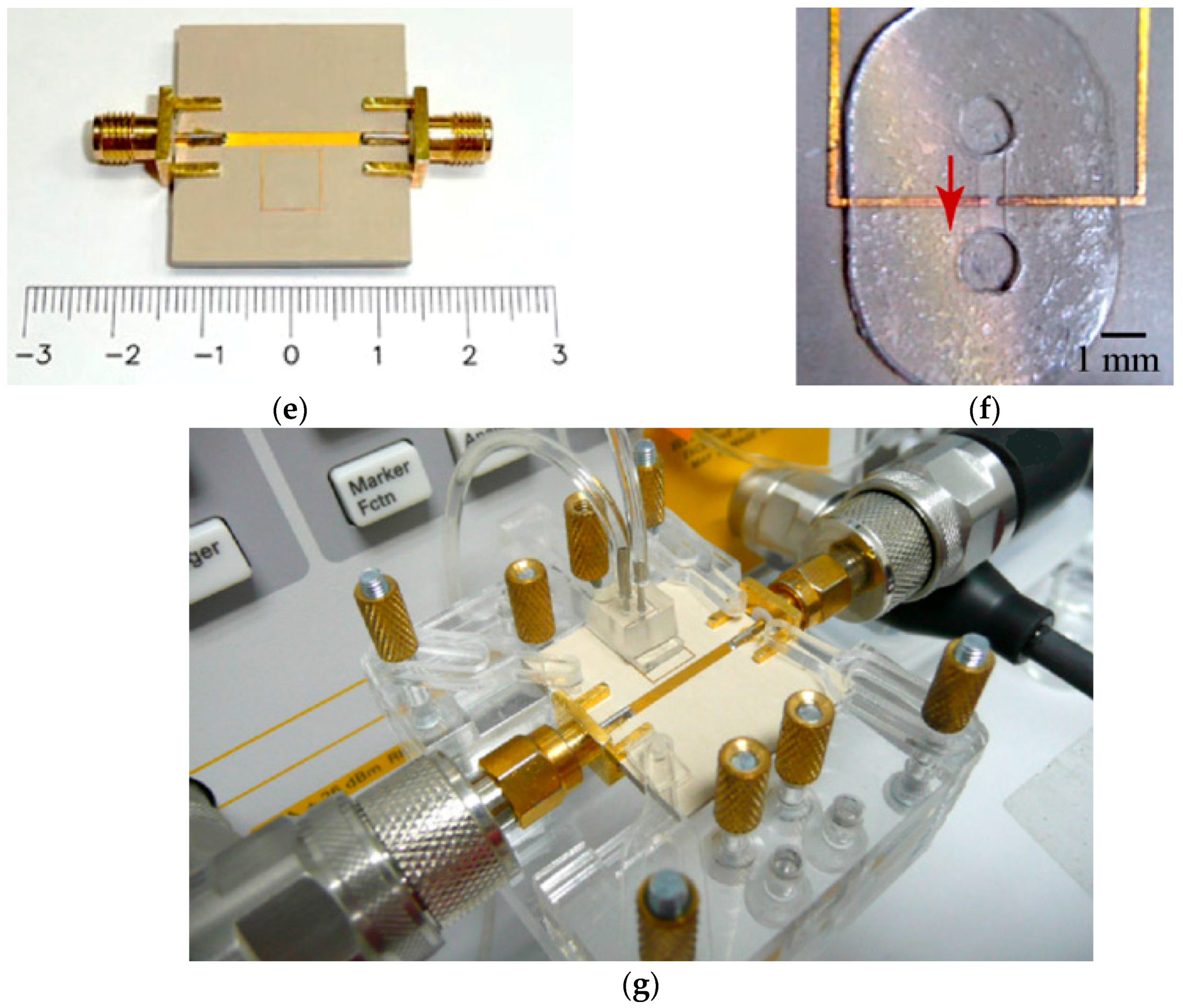
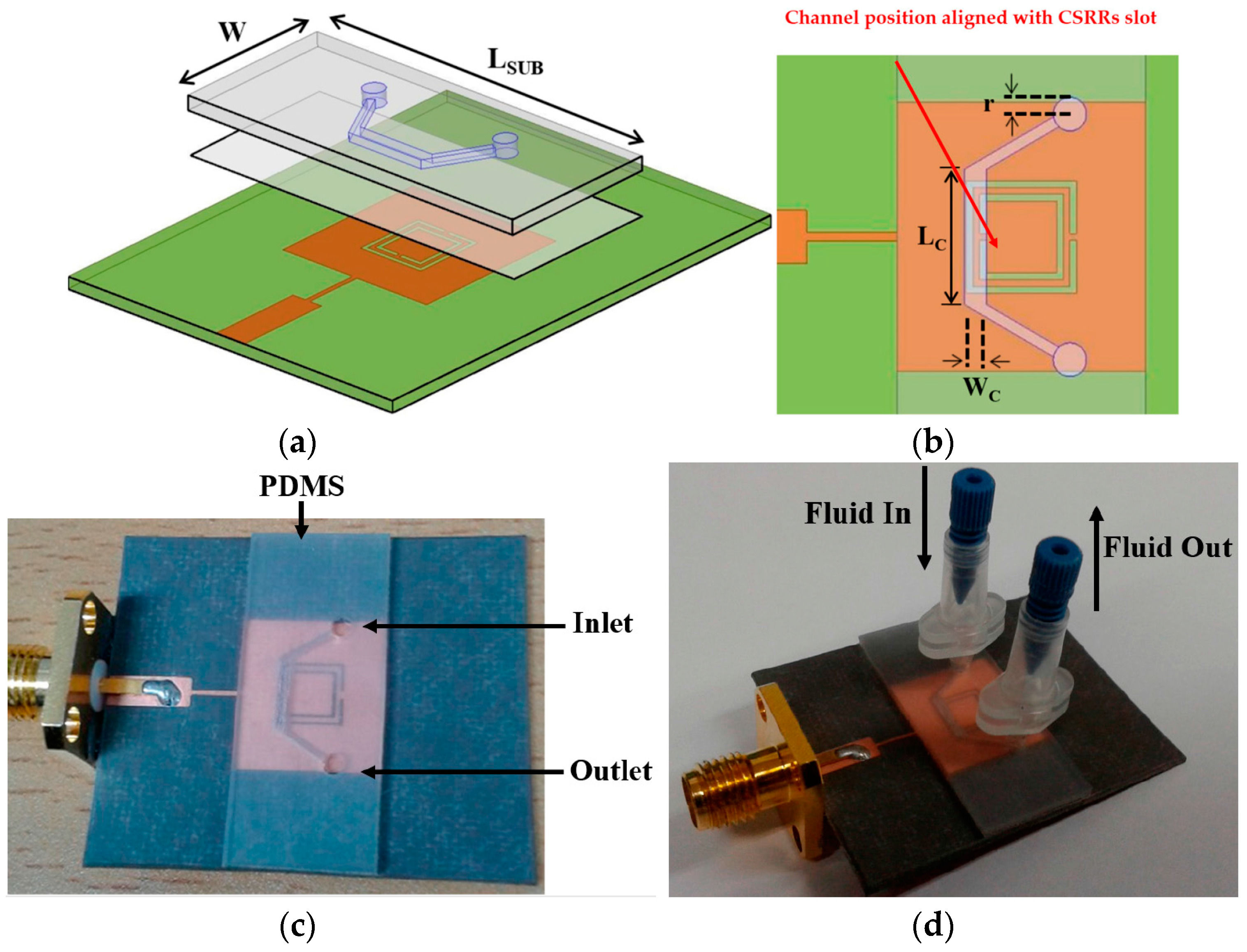



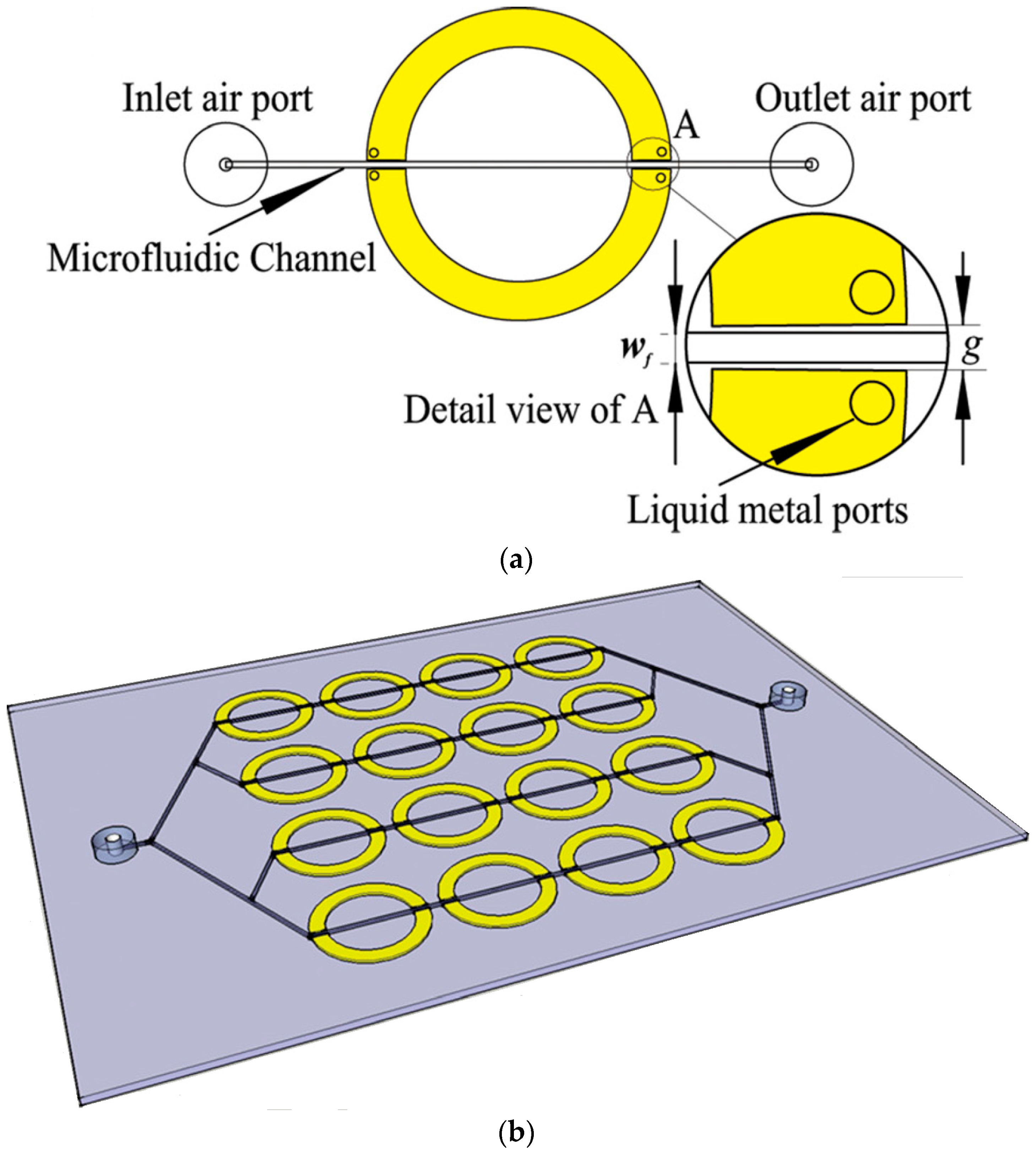
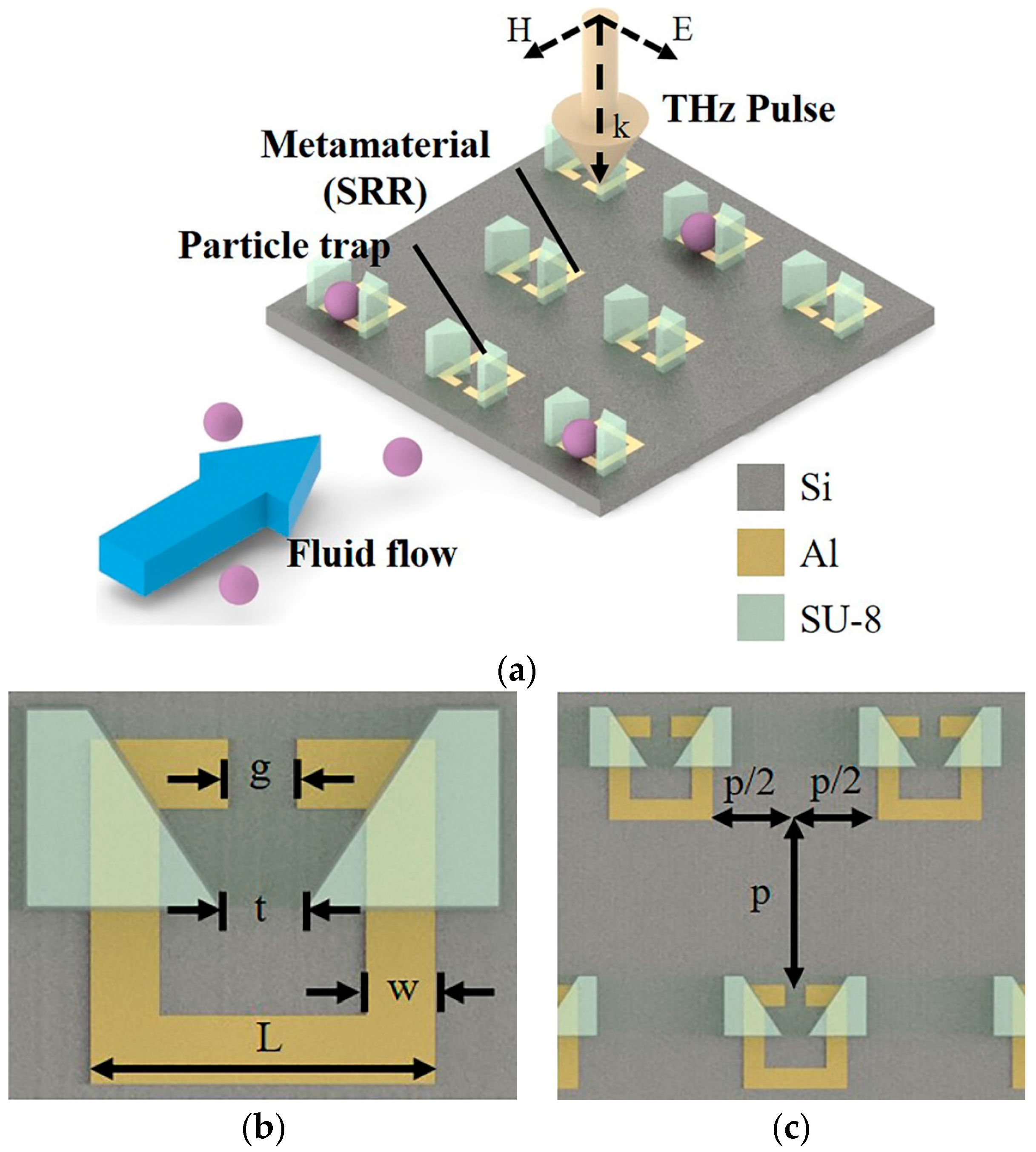
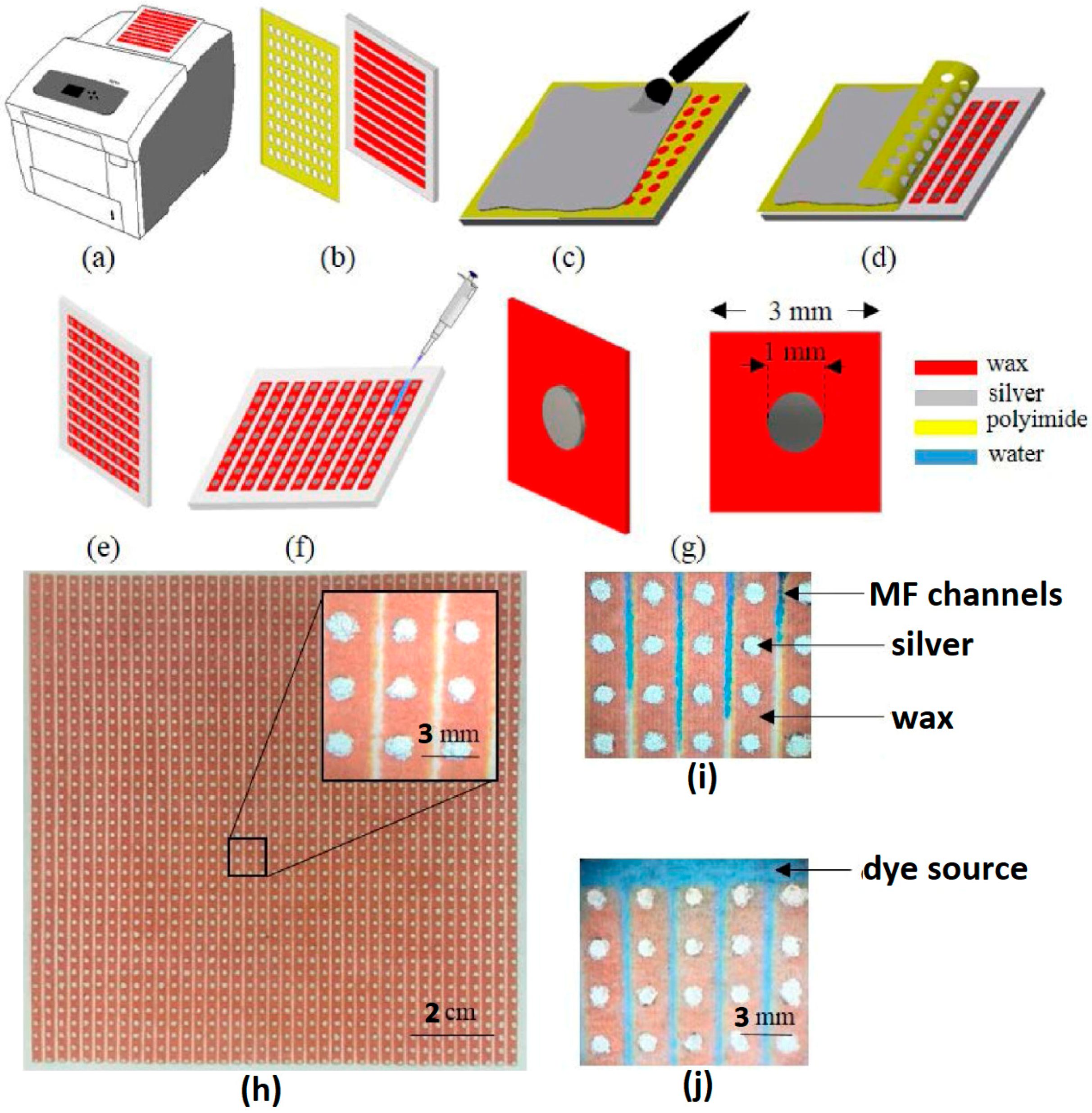



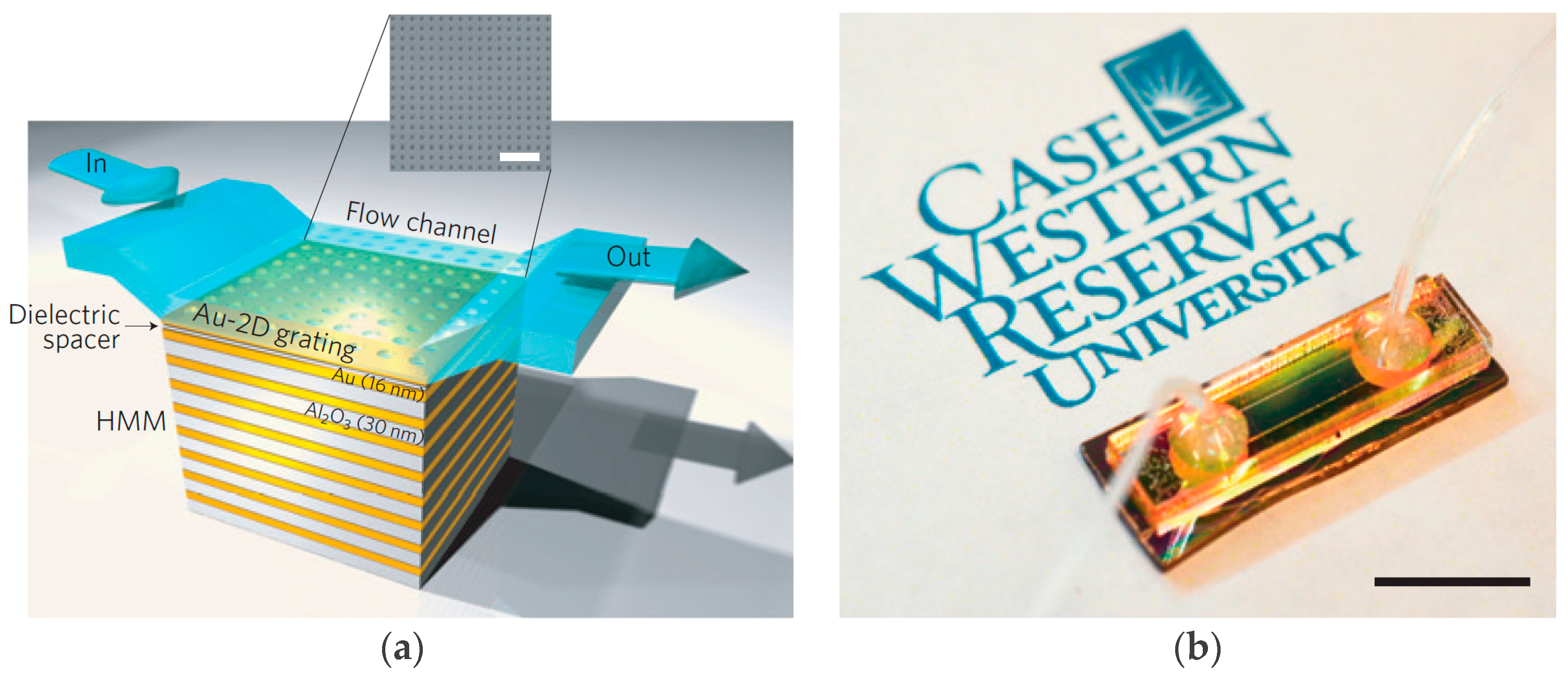
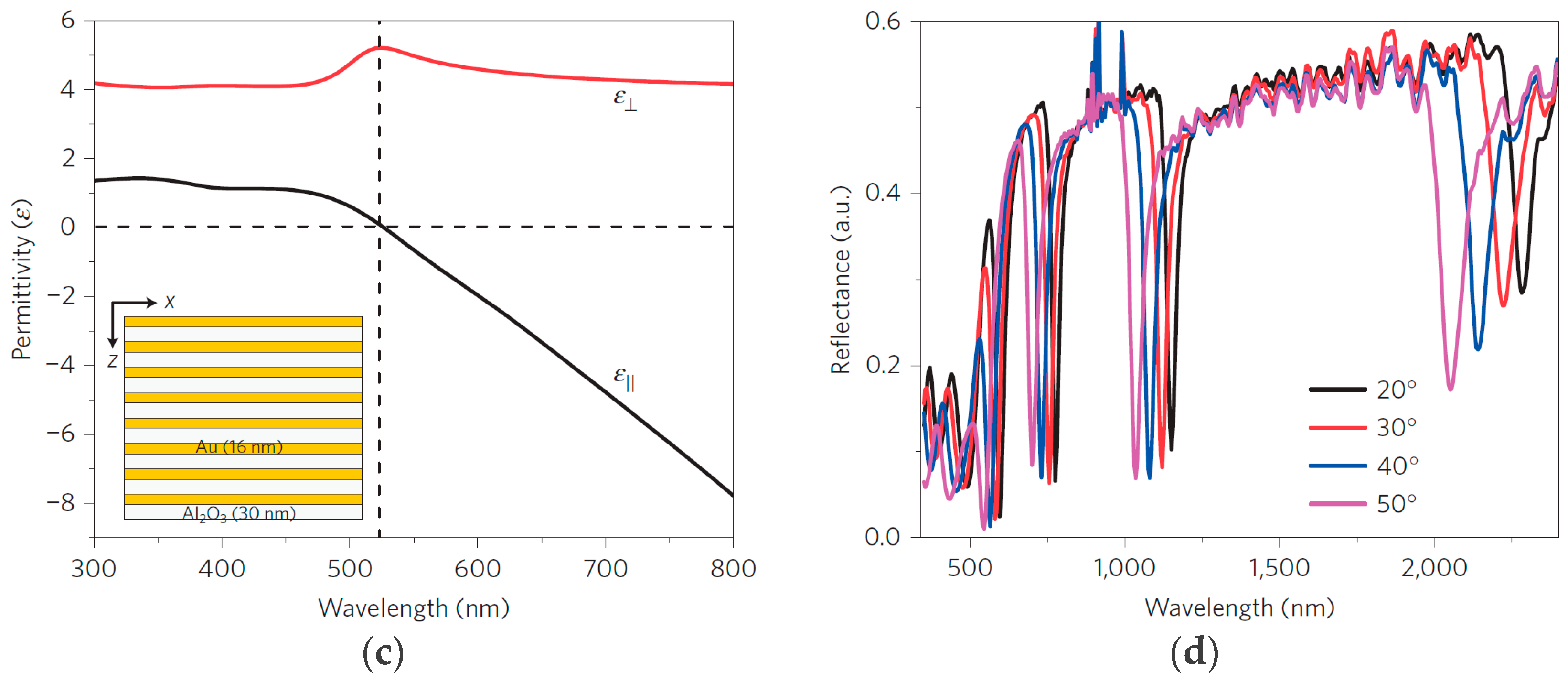

| Ref. # | Material | Permittivity εr | Loss Tangent tanδ | Frequency [GHz] |
|---|---|---|---|---|
| [9] | PMMA (Poly methyl methacrylate) | 3.2 | 0.02 | 3–4 |
| [30] | PFA (perfluoralkoxy) | 2.1 | N/S | 3 |
| [30] | Quartz | 3.8 | N/S | 3 |
| [52] | PDMS | 2.5–2.7 | 0.01–0.04 | 2–3 |
| [53] | PTFE—Teflon (polytetra-fluoroethylene) | 2.2 | 0.0002 | N/S |
| [54] | Glass * | 5.27 | 0.003 | 0–10 |
| Ref. # | fo [GHz] | Δf [MHz] | εa * | εwater ** | Savg [%] | MM Element | Analyte | Analyte Concentration | Flexible Substrate |
|---|---|---|---|---|---|---|---|---|---|
| [7] | 3.5 | 270 | 5.08 | 73.77 | 7.51 | CSRR | Ethanol | 10‒90% | No |
| [9] | 4 | 450 | 5.38 | 74.92 | 12.12 | MM patch | Ethanol | 0‒100% | Yes |
| [30] ‡ | 3 | 47.4 | 5.99 | 75 | 1.72 | DSSR | Ethanol | 0‒100% | No |
| [33] | 1.9 | 110 | 8 | 76.5 | 6.49 | SRR | Ethanol | 0‒100% | No |
| [34] | 2.4 | 400 | 6.6 | 76.6 | 16.58 | CSRR | Ethanol | 10‒90% | No |
| [35] | 11 | 1040 | 5 † | 60 | 10.32 | SRCR | Ethanol | 0‒100% | No |
| [37] | 6.5 | 575 | 10 †† | 72 | 10.28 | OSRR | Methanol | 0‒100% | No |
| [38] | 4.5 | 50 | 5.21 | 74.4 | 1.14 | SRR | Ethanol | 10‒95% | No |
| [39] | 0.87 | 70 | 14 | 80 | 8.95 | SRR | Ethanol | 10‒90% | No |
| [40] | 3 | 60 | 5.99 | 75 | 1.98 | SRR | Ethanol | 10‒90% | Yes |
| [48] | 10 | 1140 | 5 † | 63.01 | 12.39 | SRCR | Ethanol | 0‒100% | Yes |
| Ref. # | Biological Substances | Conductivity [S/m] | Permittivity εr |
|---|---|---|---|
| [61] | Fungi (Neurospora sitophila or Aspergillus niger) | N/S * | 8 |
| [62] | Breast Phantom (20:80) @ 3 GHz | 0.91 | 12.13 |
| [62] | Breast Tumor @ 3 GHz | 3.14 | 55.45 |
| [74] | Fat | 0.03–0.06 | 5.9–6.6 |
| [74] | Liver | 0.4–0.5 | 65–81 |
| [74] | Wet Skin | 0.47–0.55 | 60–72 |
| [75] | SW-620 cell line (colorectal cancerous cell) | 0.02 | N/S * |
| [76] | U87 glial cells (cells in central nervous system) | 0.1 | 42 |
| [28] | MRC-5 cell line (Human Lungs Fibroblast cells) | N/S * | 53 |
© 2018 by the authors. Licensee MDPI, Basel, Switzerland. This article is an open access article distributed under the terms and conditions of the Creative Commons Attribution (CC BY) license (http://creativecommons.org/licenses/by/4.0/).
Share and Cite
Salim, A.; Lim, S. Review of Recent Metamaterial Microfluidic Sensors. Sensors 2018, 18, 232. https://doi.org/10.3390/s18010232
Salim A, Lim S. Review of Recent Metamaterial Microfluidic Sensors. Sensors. 2018; 18(1):232. https://doi.org/10.3390/s18010232
Chicago/Turabian StyleSalim, Ahmed, and Sungjoon Lim. 2018. "Review of Recent Metamaterial Microfluidic Sensors" Sensors 18, no. 1: 232. https://doi.org/10.3390/s18010232





